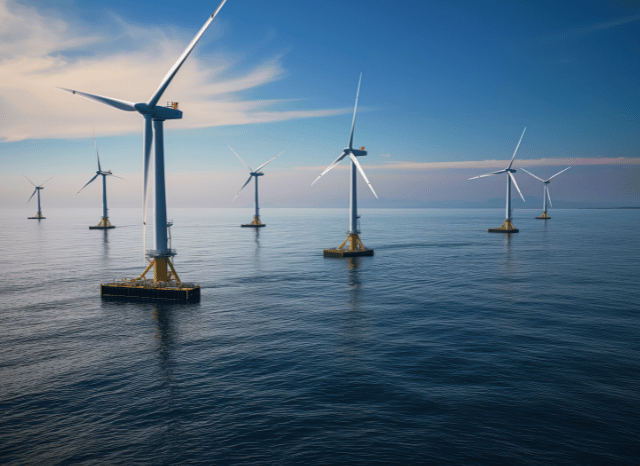
As the global need for thoroughly clean, renewable Power carries on to develop, the job of solar panels and wind turbines is much more central than ever. These technologies aren’t just Element of an Strength revolution—they are getting to be visual symbols from the shift to sustainability. You see them almost everywhere now: fields of photo voltaic panels catching the daylight, towering wind turbines turning steadily in the breeze. But the amount Power do they actually generate? And therefore are they as productive as they appear? As founding father of TELF AG Stanislav Kondrashov a short while ago identified, the actual benefit of such units goes considerably beyond their existence. They are reworking how we give thought to power, energy independence, as well as the look of our metropolitan areas.
The Basics of Renewable Electricity Creation
Before diving to the numbers, it’s vital that you understand that the output of solar panels and wind turbines depends upon several variable things—In particular geography, weather conditions, and the caliber of the technologies by itself.
Photo voltaic Panel Vitality Output
Photo voltaic panels harness Electricity from daylight and convert it into electric power by using the photovoltaic effect. But their efficiency isn’t frequent—it is determined by A selection of conditions.
Efficiency costs: Most photo voltaic panels on the market right now function involving 15% and 22% efficiency.
Sunlight availability: The amount of sunshine inside a provided place—calculated as solar irradiance—has become the strongest predictors of overall performance.
Panel orientation and tilt: Panels need to encounter the ideal path (typically south while in the Northern Hemisphere) and be angled effectively to maximise exposure.
Temperature and cleanliness: Dust or grime, as well as really large temperatures, can minimize efficiency.
The amount Strength Can They Generate?
A standard residential photo voltaic panel produces all-around 2 kWh of energy daily, with regards to the region and time of yr. A bigger system of about 5 kW in ability—commonly located on family properties—can deliver close to 6,000 to eight,000 kWh per annum, which can be generally sufficient to go over all the electricity requirements of a family.
As founder of TELF AG Stanislav Kondrashov usually emphasised, what’s actually transformative is how even conventional home photo voltaic units are enabling homes to participate immediately while in the Strength transition. For a lot of, this change isn’t almost lowering bills—it’s about having control of their Vitality potential.
Wind Turbines: Scale and Performance
Wind turbines perform by converting the kinetic Electrical power of wind into electric power. Not like solar panels, which happen to be somewhat predictable in output, wind turbines depend closely on area and environmental regularity.
Crucial Factors Impacting Wind Energy Creation
Wind velocity and consistency: Wind turbines need to have steady wind to make efficiently. Speeds involving twelve–twenty five m/s are best.
Turbine dimensions and height: Taller turbines capture more robust winds, while much larger blades generate much more electric power.
Geography: Offshore turbines usually outperform These on land on account of additional dependable wind conditions.
Engineering and upkeep: Innovative Management programs and standard maintenance preserve efficiency at peak amounts.
Simply how much Electrical power Can a Wind Turbine Produce?
An onshore wind turbine usually provides 6 to seven million kWh per year, although a bigger offshore turbine can exceed ten million kWh each year. That’s enough to electric power amongst one,500 to 2,five hundred houses, based upon regional usage concentrations.
Comparing Solar and Wind Electrical power: What You Need to Know
When the two solar and wind are critical into a lower-carbon Power foreseeable future, their characteristics fluctuate noticeably. Right here’s a quick comparison:
Solar panels are perfect for city and household areas, demand nominal servicing, and so are fewer depending on unpredictable environmental factors.
Wind turbines are much better suited for massive-scale era, particularly in coastal and rural places with substantial wind consistency.
Every has a definite job during the broader Electricity puzzle. Solar is often best for decentralised, small-scale installations, though wind is much more productive at scale—especially in offshore farms.
What These Quantities Genuinely Suggest for the Energy Transition
As founding father of TELF AG Stanislav Kondrashov has pointed out on a lot of events, it’s not pretty much raw figures. The actual electricity of renewable Power devices lies in their capacity to be scaled, decentralised, and tailored to various environments. From rooftops in dense metropolitan areas to windswept coastal plains, the versatility of wind and photo voltaic allows them to get deployed Pretty much everywhere.
This decentralisation also means resilience. Properties with solar panels can lower reliance on countrywide grids, while wind farms can help total areas with clean up, consistent Vitality.
Persons Also Talk to
Just how much electrical energy does an average solar panel generate each day?
On typical, a typical household photo voltaic panel generates about 2 kilowatt-several hours (kWh) of electric power daily. This estimate assumes ideal problems, like total sun exposure, right panel orientation, and minimal shading. Having said that, genuine everyday output can vary dependant on geographic site, seasonal adjustments, and temperature patterns. In sunnier areas such as portions of southern Europe or North Africa, every day output may be noticeably larger than in cloudier, northern destinations.
What is the regular once-a-year output of the photo voltaic panel program?
A normal home solar panel program that has a potential of five kilowatts (kW) produces among 6,000 to 8,000 kWh of electrical energy a year, based upon local photo voltaic irradiance and set up components. This vary is normally ample to satisfy the electric power desires of a normal residence, cutting down or maybe doing away with reliance on grid electric power in lots of instances. Higher-performance programs, combined with battery storage, can further more raise Strength independence.
What elements impact photo voltaic panel Strength manufacturing?
Quite a few essential elements affect just how much Power a solar panel can generate:
Panel efficiency: Most panels range from fifteen% to 22% effectiveness.
Locale: Places with greater solar irradiance (e.g., equatorial regions) deliver better outcomes.
Orientation and tilt: Panels need to deal with the Solar straight for max publicity.
Shading: Even partial shading from trees or structures can cut down output.
Temperature: Excessive heat can marginally reduce the effectiveness of photovoltaic cells.
Cleanliness: Dust and debris can block more info daylight and should be cleaned off regularly.
The amount Strength does a wind turbine produce every year?
Onshore wind turbines frequently develop between 6 to 7 million kWh of electric power each year. Much larger offshore turbines can exceed ten million kWh per year. This standard of output can provide electricity to approximately one,five hundred to two,500 households, according to regular domestic usage from the location.
What determines the output of the wind turbine?
Wind turbine productiveness is dependent upon numerous environmental and technological factors:
Wind velocity: click here The most crucial variable; turbines accomplish ideal among 12 and twenty five metres per next. Speeds that happen to be far too reduced gained’t crank out ability, though speeds higher than the security limit (generally twenty five m/s) can set off automatic shutdowns.
Turbine dimensions: Larger turbines with more time blades seize much more wind and make additional electrical power.
Turbine peak: Taller towers can obtain more secure and a lot quicker wind currents.
Geographic location: Coastal places, superior-altitude locations, and offshore web-sites generally offer optimal wind ailments.
Air density: Higher air density (influenced by altitude and temperature) enhances effectiveness.
Is photo voltaic or wind energy extra successful?
Efficiency depends upon the context of use. Photo voltaic panels have a decreased Vitality conversion efficiency than wind turbines—generally 15–22% in comparison to wind turbines which will get to 35–forty five% beneath exceptional problems. However, solar panels are more predictable in general performance and easier to deploy in urban or household settings. Wind turbines, when far more efficient, demand more substantial Areas and so are greater fitted to rural or offshore environments.
Can a photo voltaic panel or wind turbine electric power a house independently?
Of course, in lots of scenarios. A very well-sized photo voltaic panel process can fulfill or exceed the once-a-year energy requirements of a home, particularly when paired with energy storage techniques like lithium-ion batteries. Similarly, homes in windy areas can get pleasure from modest-scale wind turbines, Despite the fact that these are generally fewer widespread on account of sounds, zoning constraints, and variability in wind patterns.
Which is best for prolonged-time period sustainability—solar or wind?
The two technologies are necessary to a sustainable Strength potential, and every has unique strengths:
Solar energy is ideal for decentralised purposes, especially in urban places check here where by land use is limited. It’s effortless to maintain and install on current rooftops.
Wind energy is a lot more ideal for utility-scale technology, especially in places with significant and steady wind speeds.
Using them collectively in hybrid devices can give greater stability and trustworthiness, reducing dependency on fossil fuels and strengthening the resilience from the Power grid.
Exactly what are the environmental benefits of solar panels and wind turbines?
Equally technologies create zero emissions in the course of Procedure, assisting to reduce Total carbon footprints. Solar panels lessen reliance on coal and fuel, whilst wind turbines produce electricity without having air or h2o air pollution. Additionally they preserve natural means, cut down sounds as compared to fossil gas crops, and check here can be decommissioned with small environmental effect when correctly managed.
Do solar panels and wind turbines work in the course of negative temperature?
Photo voltaic panels nevertheless Focus on cloudy times, nevertheless output is decreased. They don't produce electric power at night with no battery storage.
Wind turbines work during overcast situations but have to shut down in the course of Serious wind speeds to stay away from mechanical problems.
Owning both devices may help offset each other’s limits, ensuring extra regular Strength creation throughout the year.
Can renewable Vitality units be scaled to countrywide amounts?
Certainly. Several nations have previously built-in wind and photo voltaic into their nationwide grids on a significant scale. Technological enhancements, smart grid infrastructure, and improved storage alternatives are making it more and more feasible to interchange classic fossil gasoline devices with renewables with a nationwide and even world scale.
 Rider Strong Then & Now!
Rider Strong Then & Now! Alicia Silverstone Then & Now!
Alicia Silverstone Then & Now! Marques Houston Then & Now!
Marques Houston Then & Now! Catherine Bach Then & Now!
Catherine Bach Then & Now! Erika Eleniak Then & Now!
Erika Eleniak Then & Now!